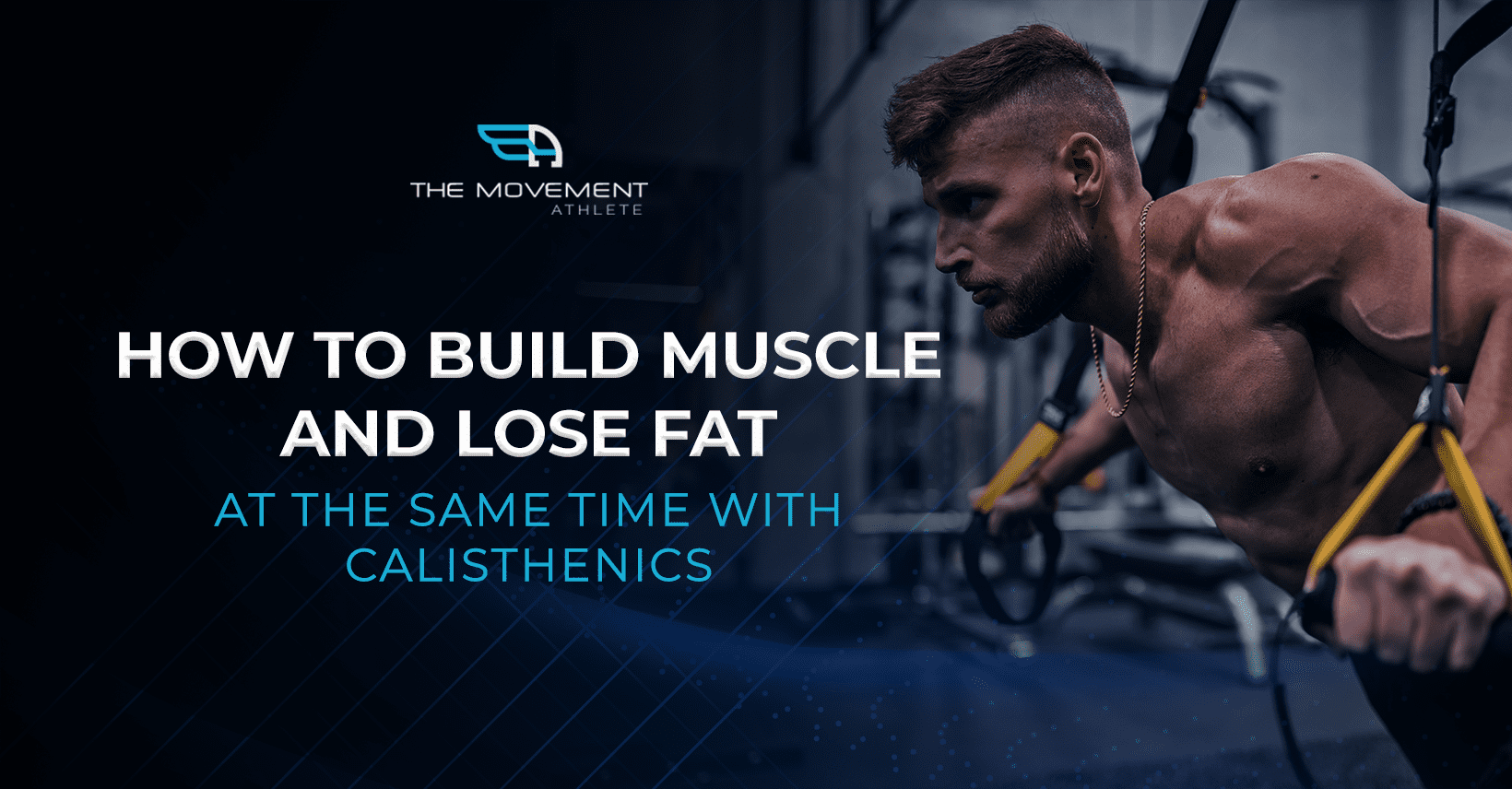

📖 Read Time: 12 Minutes
🏋️ Join the tribe of Movement & Calisthenics Athletes
People just like you that are working with their own body weight to get strength, lose fat, build muscle, recover from injuries and live their best lives!
One thing that always amazed me about calisthenics and bodyweight training is how both naturally normalize and regulate your body fat levels and let you build muscles that are lean. 💪
So yes, you can lose weight and build muscle at the same time with calisthenics, but the KEY is the RIGHT PROGRAMMING.
Who doesn’t want to gain some muscles while losing fat so you’ll look and feel healthy for the rest of your life? 😊
If you’re interested, keep on reading so you can experience the amazing benefits that calisthenics can bring you.
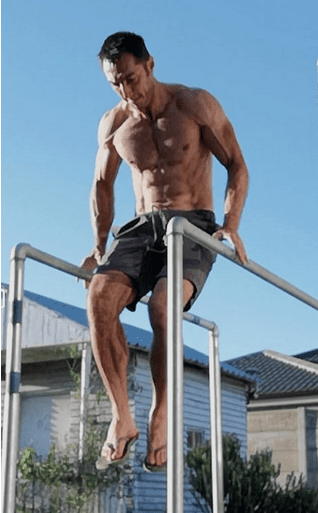
First, let’s look at the FAT LOSS & CALISTHENICS
Again and again and again I have seen guys and girls who take up bodyweight training naturally drop flab, just as a side effect of their fitness.
How is it possible? 🤔
Why are calisthenics so effective for fat loss?
Obesity and Calisthenics are natural enemies. If your goal lifting is to bent-over row 400 lbs., you could overeat as much as you like and probably still meet your weight despite carrying around a massive gut.
But you couldn’t set a goal of doing one-arm pull-ups without watching your bodyweight. When you bulk up from Calisthenics and Bodyweight training it’ll be because you NEED that muscle. You’ll NEVER gain unneeded fat while training because your body recognizes that slows down your bodyweight aspirations.
The power of your subconscious mind
The goal of calisthenics is to master lifting one’s own body. The fatter you are, the more difficult this becomes. Once you begin training regularly in calisthenics, the subconscious mind makes the connection between a leaner body weight and easier training, and regulates the appetite and eating habits automatically.
How is it possible? It’s actually very simple. Imagine you are doing a handstand pushup. You are training your body telling it that this is what it needs to handle, handle the weight drops to the appropriate level. And as you are training all the muscles it builds an incredible natural physique.
Drop the flab and build natural physique of a gymnast
If you are a few pounds off you still will need a clean diet regime. But bodyweight training will naturally shed you and give you the best possible, natural results. I know this is true-I’ve seen it myself on many occasions. Guys who take up bodyweight training naturally drop flab and eventually have 6 pack abs.
So now you know that on its own calisthenics can be very effective because of how it’s designed.
Now we will look more into details of how to optimize your training for fat loss.
📌 Fat loss vs weight loss
Let’s clarify something here first. Fat loss and weight loss are not necessarily the same thing.
When we talk about fat loss, we are pertaining to the fats being burnt from your body. Weight loss is the total mass loss from your body including fats and lean muscle.
We should aim for fat loss and not just weight loss in general.
Gaining weight and building muscle is another story since you’ll be gaining a bit of fat, too when trying to build up some weight.
If that’s the case, don’t worry about it. We’ve got you covered in this article: the ultimate guide on how to build muscle.
🎯 Why you should aim more than just fat loss
Talking about weight loss, there are 3 ways you can do it but one is superior over the other. You can:
• Lose weight through your diet with caloric deficit – eating less calories than your body needed to maintain weight
• Caloric deficit while doing cardio
• Lose weight through caloric deficit while implementing resistance training

Diet 🥜 alone
When you practice the first one, you’ll be losing fat as well as muscle mass. You’ll not be as strong and you won’t look that good with that body. Fat loss will take some time because you’ll only rely on your base metabolic rate. It’s the rate of energy (calories) being burned by your body.
Since you’re not using muscles, your body will undergo muscle atrophy. You’ll be losing muscle mass alongside with your fats.
When done rapidly, it might take a negative affect your metabolic rate and slowing it down. Making it more difficult to lose weight and it’s also not very sustainable. It’s also not very fun to do.
Diet 🥜 + cardio 🏃♂️
The next option is proper diet with cardio. This is good since you’ll burn more fat because your body would be burning calories through your aerobic exercise. You’ll also get excellent benefits from aerobic exercise such as:
• Stronger and healthier heart and lungs
• Decrease risk of heart and lungs diseases
• Lower blood pressure
• Regulated blood sugar
• Better mood
• Better sleep
• Overall better quality of health
The issue with if done in longer periods of time, you’ll lose muscle and basically you won’t be gaining much muscle from this option.
Diet 🥜 + cardio 🏃♂️ + resistance training 💪
The other choice you’ll be proper diet, aerobic and resistance training. With the addition of resistance training, you can assure that you’ll be burning more fat because of higher metabolic rate as well as gain muscle.
Fat loss will be a lot faster compared to the other options because building muscle needs more energy. The more lean muscle you have, the faster you fats also get burned. Muscles cells assist in burning fatty acids and glycogen in the body. Your body will also be burning fats not only during workout but also throughout the day.
According to research, combining resistance training and cardio would be the best way. You’ll be losing weight from all the burnt fat while maintaining or even developing your lean muscle mass thanks to resistance training.
Developing muscle mass doesn’t automatically mean you’ll be aiming to get a physique like Arnold Schwarzenegger.
Getting lean muscle mass means you’ll enjoy:
• Getting a lot stronger
• Faster metabolism
• Decreased risks of getting heart diseases and other conditions
• Better confidence
And add also the benefits the previous benefits stated from your cardio training.
Keep in mind that cardio and resistance training should be programmed well that it won’t cause you to overtrain. Overtraining will do harm to your gains and even your motivation which might ultimately make you quit. We want to avoid that so keep on reading to know the program that would work for you.
An excellent type of resistance training for you is calisthenics.
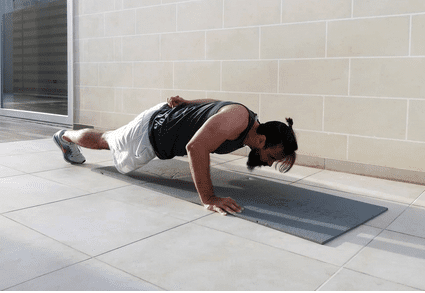
🔎 Why choose calisthenics as your resistance training?
Calisthenics trains your body holistically.
🔖 Calisthenics, done properly, is very progressive in nature and will help increase your mobility and build bulletproof joints that resist injury.
You’ll be assured that your workout will satisfy the requirements needed in order to build muscle and lose fat.
In addition to that, you will also get to improve other components and aspects of fitness. Not only you’ll get stronger and better physique, you’ll also get more mobile, better endurance, better balance, body control and so much more!
When choosing your workout approach, it’s important not just to look at the short term goals. You need to look for a lifelong approach that can help you in your lifelong fitness journey.
Calisthenics could be your lifelong approach and taking our free assessment can be your lifelong partner in your fitness journey.
📌 Body re-composition
So let’s get back again to your physique.
Now, you’ve heard that you can be losing fat while gaining muscle. Amazing, right? ✨
And you can also maintain your weight while doing this if that fits your goal.
This is commonly called as body re-composition. Basically, you’ll be losing fat mass and gaining lean muscle at the same time while maintaining weight.
Sounds impossible since you need to be in a caloric deficit to lose fat while caloric surplus to gain muscle.
So how can you go about it? It would highly depend on your nutrition and quality of training.
But you must be warned that body recomposition isn’t actually for everyone. There are some types of people who would benefit from it and there are others who aren’t.
🎯 Aiming for main muscle mass?
Hard-gainers planning to build much muscle as you can should, well, focus on that goal. This means that your strategy especially in nutrition is going to be a little different compared to body re-composition. You’ll also gain a tad bit more fat, but don’t worry. It’s all part of the plan.
Here’s the ultimate guide on how to build muscle to get you started on your journey.
How to optimize muscle building and fat loss at the same time
There are three main factors affecting your goals here:
1. Workout
2. Nutrition
3. Rest
Get that 3 things in line they you’ll be seeing your goal in the near future.
1. Your workout program matters 👊
We’ll be talking about two things that would determine your muscle growth through your workout:
– Mechanical tension (the load or weight your muscles handle) and
– The Total Work volume done (total amount of weight moved by the muscle over a certain period of time).
💪 Mechanical tension
Mechanical tension is the force you exposed your muscles unto while you contract your muscles against a type of resistance; in our case, our bodyweight. Other examples of resistance you can use are dumbbells, barbells, weight plates, kettlebells. You can even find alternatives from your environment. You check your alternatives here.
Mechanical tension is basically states that you need to go heavy on your training.
As mentioned earlier, calisthenics is naturally progressive. There are tons of progressions and variations to choose from. The approach can accommodate every level of fitness from absolute beginners to high-level advanced athletes.
With tension, you would also need to consider time under tension, or the length of time that your muscles are under tension.
You can add time by executing the exercises in a slow tempo rather than doing it fast. There’s a study that supports that time under tension promotes greater muscle growth compared to lifting heavy. More time under tension means you can’t lift heavier since you’ll fatigue faster.
The issue with this is that it does not promote better strength gains.
You can solve this by implementing exercises that focus on each factor in your workout. This way, you can maximize both strength gains and muscle gains at the same time in your training.
With a proper calisthenics training plan, your workout structure adjusts to your current skill level and situation. In this way, you’ll maximize your mechanical tension in each training. Nothing will be too easy or too difficult in your workout.
You’ll be maximizing your muscle gains and strength gains in each repetition.
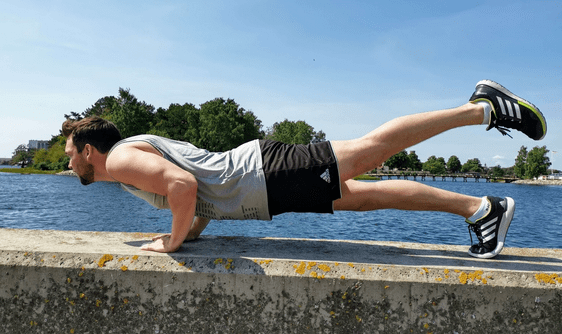
How to create mechanical tension in your workout?
First, you need to know where you are in your fitness journey. For example with upper body pushing strength, know what push-up variation you can start with.
From the assessment, you should start with the appropriate progression for you that allows you to execute a full range of motion of the exercise for a number of reps and sets while providing enough resistance to challenge your muscle fibers for growth.
Don’t cut your movement short!
Taking a full range of motion is not a small thing. Full range of motion or full ROM means executing the complete point to point motion of the exercise and not cutting the motion short.
For example on push-ups, full range of motion means each repetition of the exercise, you’ll lower down to where your chest is almost flat on the ground then push up back to the starting position where you arms are full extended and scapula fully protracted once again.
According to research, executing a full range of motion in your exercises will lead to better strength and muscle gains compared to when you’re cutting your motion short.
Finding the right intensity.
It’s a common idea that to build strength and muscle, you need to “lift heavy”. This is true especially if you’re a beginner or just coming from a training hiatus.
Using a high intensity exercises or heaviest progression in calisthenics will get you far when you’re training from a beginner like status. Even if you are an experienced athlete, going heavy will also give you the best results.
Doing a moderate intensity exercise could still assist in muscle growth but it should be coupled with the correct amount of volume which we will talk about later.
But at some point, high intensity exercise would focus more on building strength than building muscle, especially if you are a trained individual. That’s why it is important to incorporate both high intensity with moderate intensity exercises.
For beginners, it’s better to focus on strength building since it would still help you build muscles while not getting much DOMS or Delayed On-set Muscle Soreness. It’s the soreness you feel the next day after a workout. It’s because the higher the volume, the higher the chance of DOMS which isn’t that necessary to build muscle.
But that’s why training with a structured approach poses such an advantage. You’ll be given an assessment and you’ll know exactly where you can start because not all beginners will start at the same point.
From your assessment, you will be given exercise progressions you can use to stimulate mechanical tension that is specific to you.
💪 Total volume of work done ⌛️
Mentioned earlier is the role of volume in building muscle. Volume refers to the amount of work that you do in a specific exercise. It can be measured through the number of reps and sets in relation to the intensity of an exercise.
When performing high intensity exercises, it is realistic that you’ll drop the amount of volume you’ll perform. You can’t really perform high volume along with high intensity. Both are inversely proportional to each other. As you increase intensity, you’ll lower your volume and vice versa.
So how do we go from here? In this case, aim for the proper progression that will allow you to reach around 8-12 reps in 3-5 sets. It would help you maximize your muscle growth for your workout session.
Although in recent findings, trained individuals might not achieve much strength gains while still making muscle gains from this amount of volume and appropriate proportional intensity. Beginners, however, would still stronger with this format.
Nothing to worry about since you can still incorporate both formats in your workout sessions. You can focus on strength for one exercise then focus on muscle building on the other.
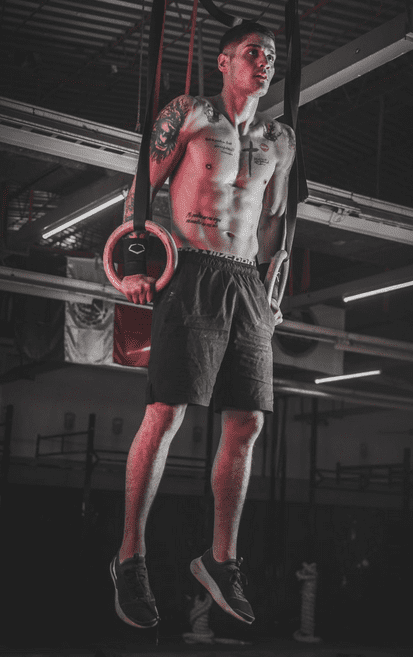
👉 What is the ultimate muscle building and fat-loss calisthenics program?
Boy, that might be a lot to take in. So what does it mean regarding your training?
It means that every individual needs a basic format but ultimately should have different individualized programs.
The ultimate muscle building and fat-loss calisthenics program is different to each and every person.
☑️ Get a tailored training routine just for you
We should respect each other’s differences even with regards to our training program. Building muscle and losing fat would be quicker if we have a program especially designed for us. Having the perfect amount of sets and reps will help us maximize our benefits from our training rather than having a cookie-cutter program that will be too hard, or too easy for you.
☑️ A lack of personalisation is hurting your training.
Imagine if some of the exercises were too hard for you. Your body will try to compensate with a poor form, movement dysfunction and possibly risk injury if it’s too challenging. You’ll also feel demotivated because you’re going to have a hard time working out. Always having your spirits down instead of up.
☑️ A lack of personalisation is hurting your training.
Imagine if some of the exercises were too hard for you. Your body will try to compensate with a poor form, movement dysfunction and possibly risk injury if it’s too challenging. You’ll also feel demotivated because you’re going to have a hard time working out. Always having your spirits down instead of up.
☑️ A lack of personalisation is hurting your training.
Imagine if some of the exercises were too hard for you. Your body will try to compensate with a poor form, movement dysfunction and possibly risk injury if it’s too challenging. You’ll also feel demotivated because you’re going to have a hard time working out. Always having your spirits down instead of up.